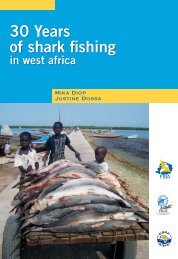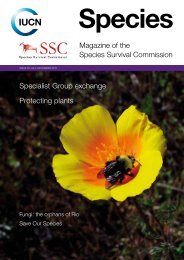Kyne & Simpfendorfer.. - Shark Specialist Group
Kyne & Simpfendorfer.. - Shark Specialist Group
Kyne & Simpfendorfer.. - Shark Specialist Group
You also want an ePaper? Increase the reach of your titles
YUMPU automatically turns print PDFs into web optimized ePapers that Google loves.
Table 2.6. Age and growth of etmopterid sharks. von Bertalanffy growth model (VBGM)<br />
parameters: L ∞ (mm TL), k (year -1 ), t 0 (years); t max oldest fish (years), A mat age at maturity<br />
(years). Band count method: Int DS, internal dorsal spine band count; Ext DS, external dorsal<br />
spine band count; Vert, vertebral band count.<br />
Species Location Method<br />
VBGM parameters<br />
L ∞ k t 0<br />
t max A mat Reference<br />
Etmopterus<br />
baxteri<br />
SE Australia Ext DS ♀ 681<br />
♂ 606<br />
0.040<br />
0.082<br />
-4.51<br />
-1.43<br />
57<br />
48<br />
30<br />
20<br />
Irvine et al. (2006a)<br />
SE Australia Int DS ♀ 693<br />
♂ 596<br />
0.116<br />
0.163<br />
-1.56<br />
-2.00<br />
26<br />
22<br />
11.5<br />
10.5<br />
Irvine et al. (2006a)<br />
Etmopterus<br />
spinax<br />
Western Mediterranean Vert -- -- -- 7 -- Gennari et al. (2002)<br />
Western Mediterranean Vert -- -- -- 7 5 Sion et al. (2002)<br />
Family Somniosidae. Sleeper <strong>Shark</strong>s.<br />
The small squaloid family Somniosidae includes the relatively well-studied Portuguese<br />
dogfish Centroscymnus coelolepis, a group of species (C. owstoni, Centroselachus crepidater<br />
and Proscymnodon plunketi) for which there is reasonable biological information, and some<br />
very poorly-known species, particularly from the genera Scymnodalatias, Scymnodon and<br />
Zameus. The vast majority of information on the biology of the family comes from the<br />
Northeast Atlantic and southeastern Australia. The systematics of Somniosus species has<br />
recently been reviewed (Yano et al. 2004) and there remains only a single undescribed species<br />
in the family, the longnose sleeper shark Somniosus sp. A. However, the only known<br />
specimen of this species, from off Portugal, was destroyed in a fire (Yano et al. 2004,<br />
Compagno in prep. a).<br />
Reproductive and age and growth parameters for somniosid sharks are summarized in Tables<br />
2.7 and 2.8, respectively.<br />
Details of the reproductive biology of the large Somniosus species is sketchy, although they<br />
are known to mature at very large sizes (~4500mm TL in female S. microcephalus, ~4350mm<br />
TL in female S. antarcticus and ~3700mm TL in female S. pacificus) (Ebert et al. 1987, Yano<br />
et al. 2007). Very large numbers of follicles have been reported for Sominosus spp, 372+ for<br />
S. pacificus (Ebert et al. 1987) and up to 2931 in S. microcephalus (Yano et al. 2007). Actual<br />
reported litter sizes are considerably smaller, 8 in S. rostratus (a smaller Somniosus reaching<br />
1140mm TL) (Barrull and Mate 2001) and at least 10 in S. microcephalus (see Yano et al.<br />
2007). Litter sizes in other somniosids range from 1–9 in C. crepidater, 1–29 in C. coelolopis,<br />
5–31 in C. owstoni to moderately high (59) in Scymondalatias albicauda (Table 2.7). Yano<br />
and Tanaka (1988) found that fecundity increased with maternal size in C. coelolepis.<br />
The lack of developing or preovulatory follicles in gravid or post-partum female somniosids<br />
indicates that there is a resting phase after parturition prior to the next pregnancy. This has<br />
been shown in such species as P. plunketi, C. crepidater, C. owstoni and C. coelolepis (Daley<br />
et al. 2002, Irvine 2004). The length of these resting periods remains undetermined as they are<br />
difficult to assess in species with aseasonal reproductive cycles, as is the case with somniosids<br />
(Irvine 2004). However, the length of the gestation period in sleeper sharks is thought to be<br />
long (1–2 years) and the existence of a resting period results in a probable reproductive cycle<br />
of 2–3 years.<br />
76
















